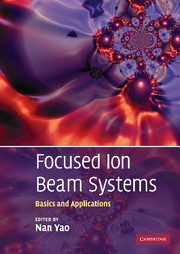Book contents
- Frontmatter
- Contents
- List of contributors
- Preface
- 1 Introduction to the focused ion beam system
- 2 Interaction of ions with matter
- 3 Gas assisted ion beam etching and deposition
- 4 Imaging using electrons and ion beams
- 5 Characterization methods using FIB/SEM DualBeam instrumentation
- 6 High-density FIB-SEM 3D nanotomography: with applications of real-time imaging during FIB milling
- 7 Fabrication of nanoscale structures using ion beams
- 8 Preparation for physico-chemical analysis
- 9 In-situ sample manipulation and imaging
- 10 Micro-machining and mask repair
- 11 Three-dimensional visualization of nanostructured materials using focused ion beam tomography
- 12 Ion beam implantation of surface layers
- 13 Applications for biological materials
- 14 Focused ion beam systems as a multifunctional tool for nanotechnology
- Index
- References
9 - In-situ sample manipulation and imaging
Published online by Cambridge University Press: 12 January 2010
- Frontmatter
- Contents
- List of contributors
- Preface
- 1 Introduction to the focused ion beam system
- 2 Interaction of ions with matter
- 3 Gas assisted ion beam etching and deposition
- 4 Imaging using electrons and ion beams
- 5 Characterization methods using FIB/SEM DualBeam instrumentation
- 6 High-density FIB-SEM 3D nanotomography: with applications of real-time imaging during FIB milling
- 7 Fabrication of nanoscale structures using ion beams
- 8 Preparation for physico-chemical analysis
- 9 In-situ sample manipulation and imaging
- 10 Micro-machining and mask repair
- 11 Three-dimensional visualization of nanostructured materials using focused ion beam tomography
- 12 Ion beam implantation of surface layers
- 13 Applications for biological materials
- 14 Focused ion beam systems as a multifunctional tool for nanotechnology
- Index
- References
Summary
Process of TEM sample preparation
Pre-thinning
Since a focused Ga ion beam with a maximum diameter at the sub-micrometer level is used in the FIB technique, the sputtering speed is not so high as in other ion milling techniques [1, 2]. To reduce the FIB milling time, pre-thinning of the sample using a polisher or cutter is required. There is no definite sample target thickness to be achieved by pre-thinning, but a typical thickness used for FIB milling is in the range of 50 to 100 μm in most cases. Preparing thinner samples promises shorter FIB milling times but we should be careful not to cause any structural and chemical changes in the sample at this stage [3]. Note that the thinner samples may become more stressed during the pre-thinning process than the thicker ones. There are various techniques and tools to be used for the pre-thinning process. A micro-cleaving system is widely used for pre-thinning of the devices with single crystal Si or GaAs substrates. The system allows cleaving of the sample including the circuit of interest quite easily and precisely and the cleaved sample may be directly FIB milled or first sliced to 10 to 20 μm using a fine blade prior to the FIB milling. In the case of polycrystalline materials such as metals, ceramics, and their composites, mechanical-polishing or dicing can be done. Relatively soft materials such as polymers, rubbers, and papers can be sliced with a razor blade.
Information
- Type
- Chapter
- Information
- Focused Ion Beam SystemsBasics and Applications, pp. 250 - 267Publisher: Cambridge University PressPrint publication year: 2007
References
Accessibility standard: Unknown
Why this information is here
This section outlines the accessibility features of this content - including support for screen readers, full keyboard navigation and high-contrast display options. This may not be relevant for you.Accessibility Information
- 2
- Cited by
